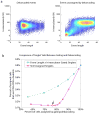Palladium-based mass tag cell barcoding with a doublet-filtering scheme and single-cell deconvolution algorithm
- PMID: 25612231
- PMCID: PMC4347881
- DOI: 10.1038/nprot.2015.020
Palladium-based mass tag cell barcoding with a doublet-filtering scheme and single-cell deconvolution algorithm
Abstract
Mass-tag cell barcoding (MCB) labels individual cell samples with unique combinatorial barcodes, after which they are pooled for processing and measurement as a single multiplexed sample. The MCB method eliminates variability between samples in antibody staining and instrument sensitivity, reduces antibody consumption and shortens instrument measurement time. Here we present an optimized MCB protocol. The use of palladium-based labeling reagents expands the number of measurement channels available for mass cytometry and reduces interference with lanthanide-based antibody measurement. An error-detecting combinatorial barcoding scheme allows cell doublets to be identified and removed from the analysis. A debarcoding algorithm that is single cell-based rather than population-based improves the accuracy and efficiency of sample deconvolution. This debarcoding algorithm has been packaged into software that allows rapid and unbiased sample deconvolution. The MCB procedure takes 3-4 h, not including sample acquisition time of ∼1 h per million cells.
Conflict of interest statement
The authors declare competing financial interests (see the HTML version of this article for details). G.P.N. has personal financial interest in the company Fluidigm, the manufacturer of the mass cytometer used in this manuscript. R.F. has been a paid consultant for the company DVS Sciences, the original manufacturer of the mass cytometer which has since merged with Fluidigm. G.K.B. has been a paid consultant for both DVS Sciences and Fluidigm.
Figures







References
-
- Fulton RJ, McDade RL, Smith PL, Kienker LJ, Kettman JR. Advanced multiplexed analysis with the FlowMetrixTM system. Clin Chem. 1997;43:1749–1756. - PubMed
-
- Krutzik PO, Nolan GP. Fluorescent cell barcoding in flow cytometry allows high-throughput drug screening and signaling profiling. Nat Methods. 2006;3:361–368. - PubMed
-
- Bandura DR, et al. Mass Cytometry: Technique for Real Time Single Cell Multitarget Immunoassay Based on Inductively Coupled Plasma Time-of-Flight Mass Spectrometry. Anal Chem. 2009;81:6813–6822. - PubMed
Publication types
MeSH terms
Substances
Grants and funding
- R33 CA183654/CA/NCI NIH HHS/United States
- HHSN268201000034C/HL/NHLBI NIH HHS/United States
- U19 AI057229/AI/NIAID NIH HHS/United States
- U19 AI100627/AI/NIAID NIH HHS/United States
- R01CA184968/CA/NCI NIH HHS/United States
- T32 GM007276/GM/NIGMS NIH HHS/United States
- N01-HV-00242/HV/NHLBI NIH HHS/United States
- T32 AI007328/AI/NIAID NIH HHS/United States
- 1 R33CA183654/CA/NCI NIH HHS/United States
- U54CA149145/CA/NCI NIH HHS/United States
- R01 AI073724/AI/NIAID NIH HHS/United States
- U54 CA149145/CA/NCI NIH HHS/United States
- 5R01AI07372405/AI/NIAID NIH HHS/United States
- R01 CA184968/CA/NCI NIH HHS/United States
- 1U19AI100627/AI/NIAID NIH HHS/United States
LinkOut - more resources
Full Text Sources
Other Literature Sources

